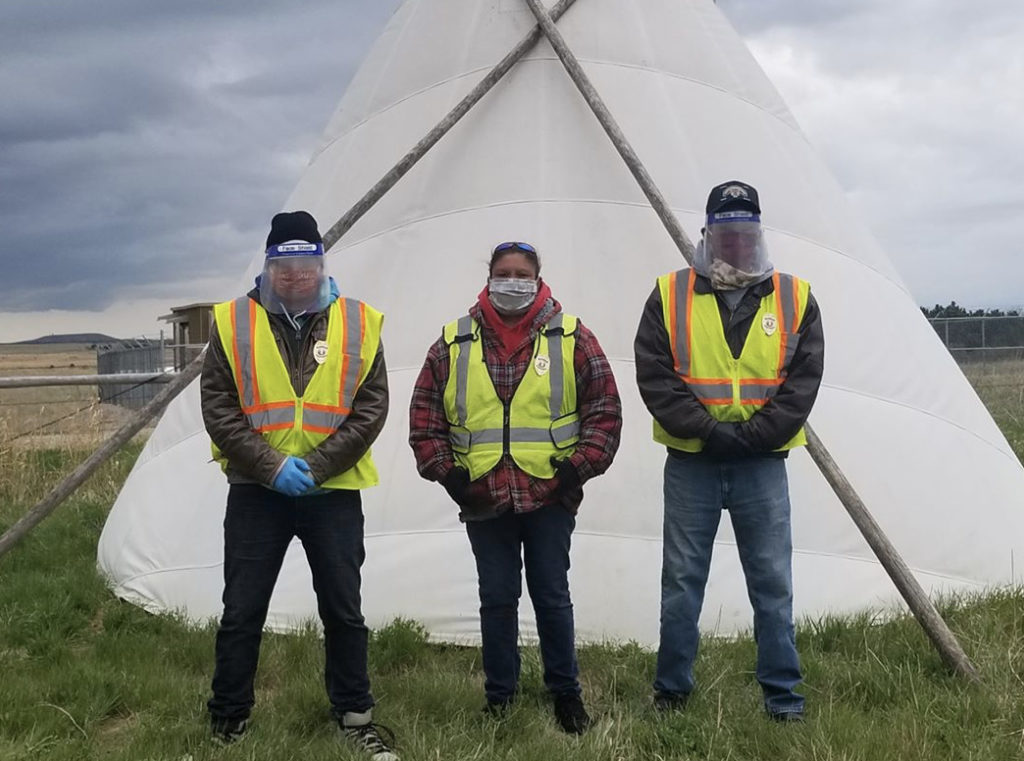Native and Indigenous people disproportionately affected by COVID-19

Tamra Borchardt-Slayton stood outside the window of the hospital where her grandmother was being treated for COVID-19. Borchardt-Slayton was only able to wave at her grandmother before she was intubated.
“Currently, my grandmother’s in the ICU. We haven’t had any contact with her; it’s one of the most heartbreaking things I’ve ever had to deal with,” she said.
As the Tribal Chairperson for Paiute Indian Tribe of Utah, Borchardt-Slayton regularly provides updates to her Tribe on the state of COVID-19 in their community. In a video posted on the Tribe’s Vimeo channel in November 2020, Borchardt-Slayton and other Native American community leaders addressed the high number of COVID-19 cases in Utah.
“COVID-19 is on everyone’s mind. And it’s impacting our Native communities especially hard,” Borchardt-Slayton said in the video.
While older people are more likely to die from COVID-19 than younger generations, Native and Indigenous people of all ages have been disproportionately affected by COVID-19. American Indian and Alaska Native people are four times more likely than Caucasian people to be hospitalized due to COVID-19, according to the Center for Disease Control and Prevention. Data from The Atlantic’s COVID Tracking Project shows American Indians and Alaska Natives in Utah are more likely to die of COVID-19 than any other racial or ethnic demographic.
Bleu Adams, co-founder of Protect Native Elders and member of the Navajo Nation and Mandan/Hidatsa Tribes, said their main mission when starting the organization was to protect Native Elders from COVID-19 because of the central role they play in Native communities.
“The elders hold our generational knowledge. They hold the community together, all of our teachings, all of our lessons, everything that we still need to gain from them, from farming techniques to ceremonial knowledge. It was all at risk of being lost,” Adams said.
Limited Resources
Adams said when she was first hearing reports of a novel virus spreading back in February, she knew instinctively that the Navajo Nation would be deeply affected.
“They were telling people to wash your hands, try to sanitize, etc. And we knew that the Navajo Nation was going to struggle because around 40% of households don’t even have running water,” she said.
With health officials recommending social distancing, Adams said the size of the Navajo Nation was another problem they faced in combating COVID-19.
“We’re the size of West Virginia and we have 13 grocery stores. So that means the first of the month when a lot of families get their money, they go to the stores, which creates huge crowds,” she said.
Davina Smith, a member of the Navajo Nation and training specialist for Restoring Ancestral Winds, said if people in tribal communities get COVID-19, it is difficult to get adequate health care. She said some people in the Navajo Nation have to drive three hours to get to a health clinic, and it is extra difficult for those who live in the mountains and have to drive on dirt roads.
Melissa Zito, director of Utah’s Office of American Indian/Alaska Native Health Affairs, said Native and Indigenous people also suffer from high rates of various underlying health conditions, including diabetes and heart disease, which can put them at a greater risk of dying from COVID-19. She said these health disparities have only been exacerbated by the pandemic.
History Between Native People and Government
Heather Tanana, University of Utah College of Law professor and member of the Navajo Nation, said COVID-19 has shed light on the challenges the Navajo Nation and other tribes have been facing for a long time. She said a lot of these challenges stem from past federal policies and mistreatment of Native people.
Tanana said while white settlers in Utah were able to establish infrastructure, tribal communities weren’t able to do the same because they were removed from their land and put on reservations by the federal government. She said that disparity can be seen in how most people in Salt Lake City have water lines running into their homes and reliable internet so they can work from home, which isn’t the case in many tribal communities.
“The actions of the government in removal, setting up reservations, terminating tribal status at one period,” Tanana said. “It’s all of those actions that have put tribal communities at a lower base level than a lot of white communities.”
The federal government has a legal obligation to provide health care to American Indians and Alaska Natives based on the Constitution and treaties between the government and Native tribes. Tanana said the U.S. government has not kept that promise, pointing to a 2018 report from the Commission on Civil Rights that outlines all of the federal funding shortfalls for tribes and Native Americans.
Adams said while Native communities don’t have the necessary support from the government or infrastructure, there have been community-based efforts like Protecting Native Elders.
“That’s a part of being Indigenous; that’s a part of our philosophy and our teaching. You always strive to help your community, especially if you have opportunity and access like I do,” she said.
But Tanana said even with donations and community support, it’s not a sustainable solution to the inequalities that Native and Indigenous communities face.
“When you talk about long-term solutions, that has to be something with the federal government fully fulfilling its obligations,” she said. “It’s going to take time because they have to catch up on replacing old infrastructure, building new infrastructure that doesn’t even exist. That’s going to take time and a significant investment, not just a one-time thing.”
The post Native and Indigenous people disproportionately affected by COVID-19 appeared first on The Daily Universe.

